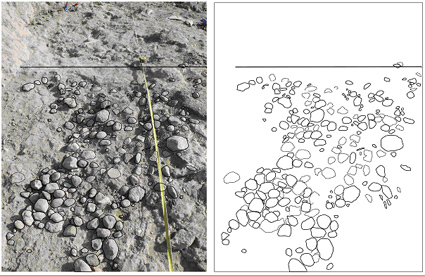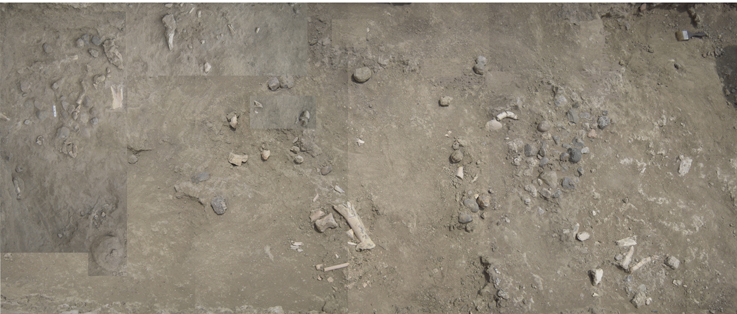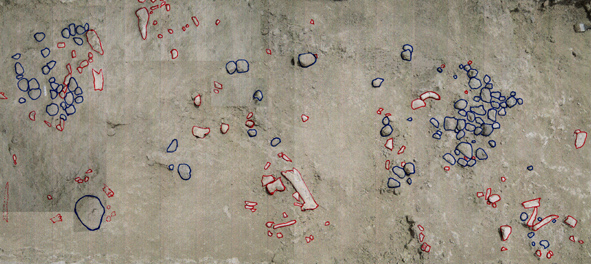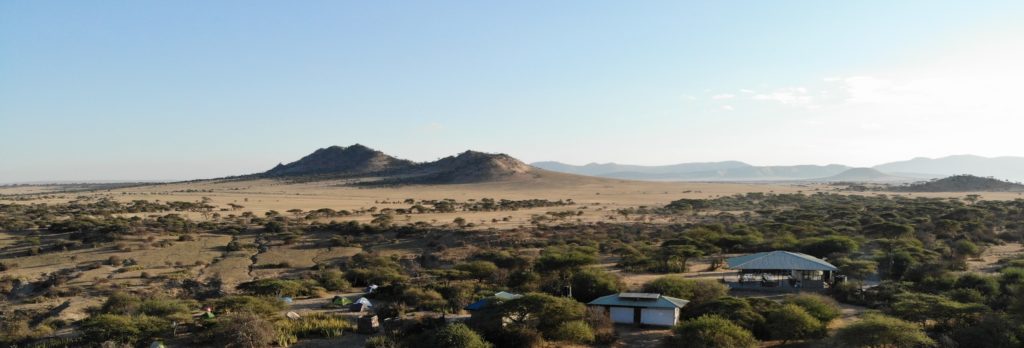
Project summary
The earliest stages of human behavior underwent a modification with the emergence of Homo erectus. With this hominin type, new technologies, such as the Acheulian and new subsistence behaviors based on the more intensive consumption of meat also emerged. The reasons for the social and adaptive complexity of those hominins are clearly reflected in the types of animals that they consumed and in the activities that they performed in their foraging places. This behavior is tightly dependent on the environmental changes underwent by East Africa at the end of the lower Pleistocene.
This project will address these evolutionary changes from a palaeoecological and behavioral point of view, by means of detailed analyses of the material evidences preserved in those sites formed by H. erectus. This information will be collected by excavating large open areas, in contrast with the more conservative test trench excavations which are more frequent in the African Plio-Pleistocene archaeology. The project will target the range of animals consumed by hominins at that time, their strategies for obtaining them, their planning and forethought as inferred from their use of lithic resources, and the functionality of their foraging places.
Read more
Human evolution shows a close link to the ecology of those ecosystems where it took place during more than six million years. North Tanzania preserves some of the best continuous fossiliferous records of human and mammal community evolution in the same region of East Africa. From the base of the Laetoli beds (almost 4,5 Ma) to the top of Olduvai Gorge (Upper Pleistocene), the fossiliferous record spans more than 4 million years of hominin evolution linked to the environmental evolution of different biomes.
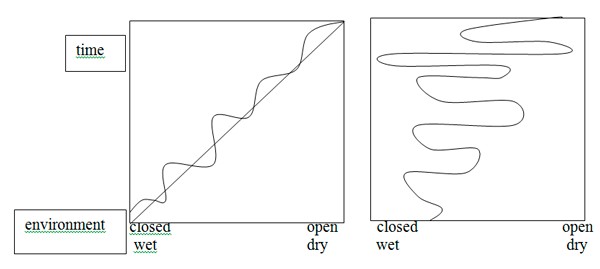
Paleoenvironmental reconstructions, based on macromammal taxonomy and ecomorphology (Shipmand & Harris, 1988; Plummer & Bishop, 1994; Spencer, 1997), micrommamal taxonomy and taphonomy (Fernández-Jalvo et al., 1998), soil isotopic analyses (Cerling & Hay, 1986; Cerling, 1992; Sikes, 1994; Sikes & Ashley, 2008), fossil pollen (Bonnefille, 1984; Bonnefille et al., 1982) and phytoliths (Bamford et al., 2006), have provided partial interpretive windows on how the landscapes evolved both at Laetoli and Olduvai Gorge for slightly more than the earliest half of this long period (Table 1). When lumping these studies together, a picture emerges of increasing aridity and openness of habitats across time (Table 1). However, this change in climate has never been proven to be neither regular nor progressive. An alternative scenario of highly fluctuating climatic changes (Figure 1) can also be inferred if attention to fluctuations in ecological conditions in modern savannas is lent.
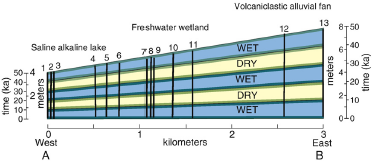
This has recently received support from the analysis of wet/dry cycles detected in lowermost Bed II (Olduvai Gorge) in response to astronomical forcing effects of eccentricity and precession of the equinox (Ashley et al., 2009). Rhythmic variability of the monsoon system produced wet periods followed by a transition into dry periods followed by a transition back into wet climate (Figure 2). These cycles have been detected through high-resolution analysis to stratigraphy. Hominin activities in the landscape vary according to dry/wet cycle, as documented in the characteristics of their discard of stone tools. This variation would remain unnoticed if a broad climatic interpretation for all (50 Ka) of lower Bed II would have been used.
If these wide climatic fluctuations are detected in very small stratigraphic intervals, it is logical to assume that they may have been fairly common across extensive stratigraphic sections. This could have had important evolutionary consequences both for hominins and the mammal community. Potts (1996) argued that Neogene mammals faced selective criteria according to their capability of adapting to highly variable and fluctuating ecological conditions. This “variability selection” would have determined the adaptation of organisms and, especially, of hominins and savannah mammal communities. The hypothesis of variability selection has undergone limited testing. In the present project we intend to provide the empirical basis for testing it by reconstructing is as much details as possible the succession of climatic conditions during most of the 4 million years of preserved fossiliferous record.
Current paleoecological evidence is insufficient for testing this hypothesis as it also is for understanding the evolution of climate and ecology in the region. There are several reasons that account for this deficiency:
- The reconstruction in an important part of the stratigraphic sequence is not existent (as for Olduvai Gorge Beds II (upper and middle II), III, IV, Masek, Ndutu and Naisiusiu and Laetoli Nadolanya and Ngaloba beds).
- In several portions of the sequence the paleoecological interpretation is based on the application of one or few of the available techniques. This is insufficient given that some of the techniques produce different results when applied to the same problem.
- Even in the same stratigraphic units where most of the available techniques to reconstruct paleoecology and paleoclimate have been used (e.g., Olduvai Gorge Bed I), they have never been jointly applied to the same stratigraphic interval. This means that every analysis is basically reconstructing stochastic climatological or paleoecological conditions that belong to different moments and are, therefore, not necessarily comparable.
In the current research program, we introduce a comprehensive research effort which goal is to reconstruct the landscape and climatic evolution in the Laetoli-Olduvai Gorge region (with emphasis in the latter area for the current proposal) for the past 4 million years. This comprehensive approach involves:
- The simultaneous use of all the available techniques to reconstruct landscape and paleoecology in the same stratigraphic intervals.
- Targeting specific stratigraphic units within each bed to undertake the study, based on the presence of hominin fossils and/or archaeological record.
- Approachig these specific units in a lateral way following outcrops of each stratigraphic interval.
- Combining the strategy described in point 3 with a thorough traditional diachronic approach, selecting stratigraphic type sections to which analyses of soil isotopes, pollen and phytoliths as well as of detailed high-resolution lithostratigraphic analyses (including research into soil micromorphology) are carried out in every single layer to detect climatic fluctuation to the highest degree of accuracy.
If a more comprehensive picture of the evolution of landscapes and climate can be made over 4 million years, both diachronically on every single geological layer preserved in the whole stratigraphic sequence as well as synchronically on targeted layer with sufficient lateral exposure and containing hominin presence, hominin habitat selection could be linked to human speciation. One of the goals of the research presented here is also to link speciation to climatic and ecological change.
Read more
Introduction
Human evolution and its link to the environment
The archaeological approach
Olduvai Gorge preserves one of the most impressive archaeological records of the world, in which two million years of human evolution is represented. The research project HUM2007-63815 focussed on the study of the archaeological sites located in the mid-upper part of Bed I. Results were highly satisfactory, as we succeeded in reconstructing the paleoecological characteristics of the sites investigated in Middle Bed I (FLK Zinj, FLKNW, FLK NN1, FLKN), and in obtaining valuable information regarding hominin behavioural complexity. The study of such chronological interval is in process of publication in a monographic issue of Quaternary Research, in which more than ten articles will be included.
We still need to finish the environmental reconstruction of Upper Bed I, where FLK N is located, and the oldest sequence of the Gorge still needs a monographic treatment (below Tuff IB, where the oldest sites of the gorge are located: FLKNN2-3, DK, MK). However, taking into account that this is a three-year project, our intention is to focus now on the following main goal: the reconstruction of human ways of living in Middle and Upper Bed II at Olduvai Gorge.
The main reasons to focus on this period are two: 1). it coincides with one of the most interesting chapters in our evolutionary history (the origin and evolution of Homo erectus/ergaster), between 1.5 and 1.2 m.a. 2). no other place in Africa can provide better information on this period, as the quality of the archaeological sites preserved at Olduvai Gorge is simply exceptional (see following section) and not comparable to other areas covering the same time-span. Traditionally, fieldwork in Olduvai Gorge has focused in the oldest beds (Bed I) and therefore, sites located in the uppermost beds were only minimally studied and excavated. This situation allows us to undertake a new project as ambitious and complete as the one already carried out in Bed I, aimed to the understanding of the connection between hominins and environment in this particular period of human evolution.
Between 2006 and 2009 we have excavated some archaeological sites in the Middle (SHK) and Upper (BK) sections of Bed II. The following conclusions were reached:
- In contrast to most of the sites located in Bed I (where hominin activity appears to be marginal or even non-existent, exception made of FLK Zinj), Bed II sites are very well preserved and are definitely anthropogenic. Therefore, these sites preserve a huge amount of information related to hominin behavior.
- The accumulation of faunal remains at BK has provided the largest bone collection bearing cut-marks and percussion marks per square meter in the world (see Domínguez-Rodrigo et al., 2009: 260-283, in Journal of Human Evolution).
- In these sites, an important collection of large animals manipulated by hominins is preserved. This poses a question: why hominins needed to consume such a large-sized animals, like the various Pelorovis (giant buffalo) specimens unearthed at BK?
- Hominin remains (two teeth) were found at BK.
- The abundant lithic (and faunal) patch retrieved from SHK and the good preservation of a number of reduction sequences within its micro-spatial context, are exceptional documents. They can be of great help in order to study the technological patterns observed at Olduvai Gorge in the framework of the processes of technical innovation (origin of the Acheulean techno-complex): different knapping methods, raw material constrains, functionality and technological transfers (Diez Martín et al., 2009).
These observations are more than enough to guarantee very valuable information covering our goal of understanding this crucial episode of human evolution. These sites (and other located in the same chronological framework, like MNK and SC) can provide valuable information in order to reconstruct human evolution between 1.5 and 1.2 m.a. Unfortunately, our knowledge of this time period is still deficient, as well preserved sequences in Africa and Eurasia from this time frame are still scarce.
The main research questions proposed in this project regarding this particular moment of human evolution are described in the following section.
Read more
References
Ashley, G.M., Tactikos, J.C. and Owen, R.B. (2009) Hominin use of springs and
wetlands: paleoclimate and archaeological records from Olduvai Gorge (1.79-174 Ma). Palaeogeography, Palaeoclimatology, Palaeoecology 272, 1-16.
Bamford, M.K., Albert, R.M. and Cabanes, D. 2006. Plio-Pleistocene macroplant fossil remains and phytoliths from Lowermost Bed II in the eastern palaeolake margin of Olduvai Gorge, Tanzania. Quaternary International. 148: 95-112.
Bonnefille, R. (1984). Palynological research at Olduvai Gorge. Research Reports n. 17, pp. 227-243. National Geographic Society.
Bonnefille, R., Potts, R., Chalie, F, Jolly D. & Peyron, O. 2004. High-resolution vegetation and climatic change associated with Pliocene Australopithecus afarensis. Proceedings National Academy of Sciences 101: 12125-12129.Cerling, T. E. and R. L. Hay, 1986, An isotopic study of paleosol carbonates from Olduvai Gorge. Quaternary Research, 25: 63-78.
Cerling, T. E. 1992, Development of grasslands and savannas in East Africa during the Neogene. Palaeogeography, Palaeoclimatology, Palaeoecology (Global and Planetary Change Section) 5: 241-247.
Diez-Martín, F., Sánchez, P., Dominguez-Rodrigo, M., Mabulla, A. Z. P., Barba, R. 2009. Where Olduvai hominins making butchering tools or battering tools? Analysis of a recently excavated lithic assemblage from BK (Bed II, Olduvai Gorge, Tanzania). Journal of Anthropological Archaeology 28, 274-289.
Domínguez-Rodrigo, M., Mabulla, Bunn, H. T., A., Diez-Martín, F., Barba, R., Egeland, C.P., Espílez, E., Egeland, A., Yravedra, J., Sánchez, P., 2009a. Unravelling hominid behavior at another anthropogenic site from Olduvai Gorge (Tanzania): new archaeological and taphonomic research at BK, Upper Bed II. Journal of Human Evolution 57, 260-283
Fernández-Jalvo, Y., C. Denys, P. Andrews, T. Williams, Y. Dauphin & L. Humphrey (1998). Taphonomy and palaeocology of Olduvai Bed I (Pleistocene, Tanzania). Journal of Human Evolution, 34: 137-172.
Plummer, T.W. & Bishop, L.C. (1994). Hominid paleocology at Olduvai Gorge, Tanzania, as indicated by antelope remains. Journal of Human Evolution, 27: 47-76.
Shipman, P. & J.M. Harris (1988). Habitat prefeence and paleoecology of Australopithecus boisei in Eastern Africa. In F. E. Grine (Ed.), Evolutionary History of the “Robust” Australopithecines, New York, Aldine de Gruyter, pp. 343-382.
Sikes, N. (1994). Early hominid habitat preferences in East Africa: paeosol carbonate isotopic evidence. Journal of Human Evolution, 27: 25-45.
Sikes, N. & Ashley, G. M. (2008). Stable isotopes of pedogenic carbonates as indicators of paleoecology in the Plio-Pleistocene (upper Bed I), western margin of the Olduvai basin. Journal of Human Evolution 53, 574-594.
Spencer, L.M. (1997). Dietary adaptations of Plio-Pleistocene bovidae: implications for hominid habitat use. Journal of Human Evolution 32, 201-228.
Objectives
- To excavate the anthropogenic sites located in the Middle and Upper Bed II at Olduvai Gorge. This frame will embrace 500.000 yr of record (1.8 to 1.2 milllion years). These sites are: BK, SHK, TK and FLK West.
- The paleoecological contextualization of these sites through a detailed landscape reconstruction, in order to understand hominin behaviors.
- The paleoecological contextualization of the process of technological change produced between the Oldowan and Acheulean techno-complexes, in order to provide new explanatory frameworks to this process. These archaeological sites are the most relevant and best preserved to study the Early Acheulean and its overlapping with the Oldowan. A main goal in this proposal is to study the meaning of the Oldowan and Acheulean techno-complexes from a behavioural, technological and functional perspectives. We are interested in understanding the relationship between both techno-complexes and how it can be accounted for at the Olduvai Gorge paleo-lake basin.
- The reconstruction of the adaptive patterns of Homo erectus/ergaster in this time-period. A comparative study of this species’ subsistence in this moment and in the previous period represented by the archaeology of Bed I sites. The meaning of big-sized animals in the diet of those hominins and their procurement strategies.
- To reconstruct the degree of human complexity during the Acheulean in the particular context of Olduvai. The hypothesis to be tested is that hominin behavior should be more complex than in previous phases of human evolution.
- To establish the link between the savannah ecosystems 1.5 million years ago and human evolution.
- To reconstruct human behavior through the extensive horizontal excavation of occupation floors, as Mary Leakey already did at FLK Zinj. Unfortunately extensive excavations have not been common research strategies in the archaeological projects undertaken in Africa during the last 30 years.
- To fulfil our goal of cooperation and development in the framework of which our research project at Olduvai Gorge was conceived. First, through the field school for Tanzanian University students and now by supporting the doctoral studies of a Tanzanian student.
Louis Leakey (1957) argued that the first H. erectus/ergaster was already hunting big-sized animals, as he documented at least 24 Pelorovis (Prehistoric giant buffalos) at BK. Later on, the same idea was cited in the literature (Cole, 1967). Since then various researchers have discussed about the purported capacity of theses humans to regularly access to large-sized animal resources, since it seemed to derive from the functional association between lithic tools and macrofaunal bones (Leakey, 1971; Bunn, 1994; Isaac, 1997). However, the revisionist period initiated in the decade of the 1980’s posed and alternative scenario: access to those resources was marginal and always linked to opportunistic strategies of passive scavenging (Binford, 1981; Potts, 1988).
Recent excavations undertaken by our team at BK in 2006 and 2009 unearthed an important accumulation of bones and stone artefacts in 5 archaeological levels (Domínguez-Rodrigo et al., 2009). In all five levels, processing of animals weighting between 50 kg and more than 1000 kg were recorded. This site constitutes and ideal arena for contrasting the alternative scenario of Homo erectus having a regular access to big animals (fauna larger than one ton) and processing them.
The excavation of one of these floors shows an occupation level only comparable to FLK Zinj. Our main goal is to dig an extensive excavation in this and, at least, two other sites (SHK and TK), exposing as much surface as possible of the living floors. In this moment, for all the African Lower Pleistocene archaeologists can only count on one of such exposures: FLK Zinj (Leakey, 1971).
On the other hand, the chronological sequence we are targeting contains sites in which we have recorded the overlapping of two different reduction models: bipolar and freehand methods (Leakey, 1971; Jones, 1994; Ludwig and Harris, 1998). Recent analysis of the lithic samples recovered from BK (Diez Martín et al., 2009) and the preliminary study of the lithic collections excavated at SHK put in evidence that the bipolar reduction technique constitutes a relevant technical solution at Olduvai Gorge. This technique was adapted to the specific particularities of rock types available. The analyzed sites constitute an exceptional source of information to investigate bipolar knapping technique, a method that has deserved little attention among researcher interested in the earliest moments of our Prehistory. These sites will also provide an interesting data to study the behavioural links related to the technical diversity witnessed by humans between 1.5 and 1.2 m.a
Read more
References
Diez-Martín, F., Sánchez, P., Dominguez-Rodrigo, M., Mabulla, A. Z. P., Barba, R. 2009. Where Olduvai hominins making butchering tools or battering tools? Analysis of a recently excavated lithic assemblage from BK (Bed II, Olduvai Gorge, Tanzania). Journal of Anthropological Archaeology 28, 274-289.
Domínguez-Rodrigo, M., Mabulla, Bunn, H. T., A., Diez-Martín, F., Barba, R., Egeland, C.P., Espílez, E., Egeland, A., Yravedra, J., Sánchez, P., 2009a. Unravelling hominid behavior at another anthropogenic site from Olduvai Gorge (Tanzania): new archaeological and taphonomic research at BK, Upper Bed II. Journal of Human Evolution 57, 260-283.
Cole, S. 1967. The Prehistory of East Africa. Mentor, Nueva York.
Jones, P.R., 1994. Results of experimental work in relation to the stone industries of Olduvai Gorge. In: Leakey, M. (Ed.), Olduvai Gorge 5. Excavations in Beds III, IV and the Masek Beds, 1968-1979. Cambridge University Press, Cambridge, pp.254-298.
Leakey, L. 1957. Preliminary report on a Chellean living site at BKII, Olduvai. In (Clark, J.D., Cole, S., eds.) Proceedings of the 3rd. Panafrican Congress on Prehistory, Londres, Chatto & Windus, pp 217-218.
Leakey, M. 1971. Olduvai Gorge. Volume III. Cambridge University Press, Cambridge.
Ludwig, B. y Harris, J., 1998. Towards a technological reassessment of East African Plio-Pleistocene lithic assemblages. In: Petraliga, M. and Korisettar, R. (Eds.). Early human behaviour in global context. Routledge, London, pp. 84-10.
